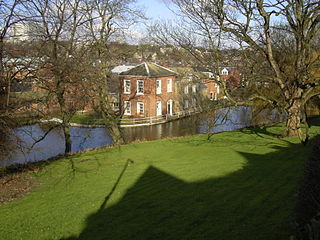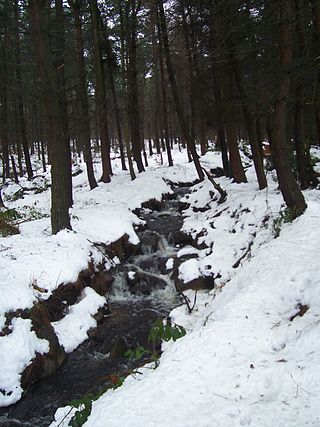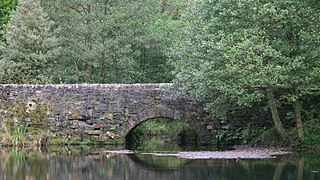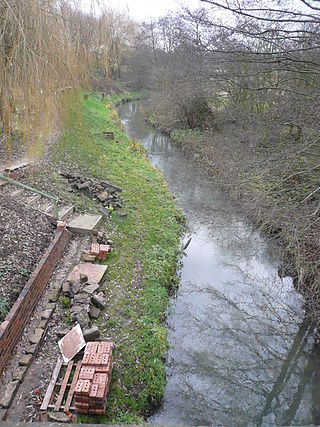Moss Valley is home to the Eckington Woods and Bluebell Woods, the latter being a local term coined because of the quantity of bluebells which cover the woods in the springtime.
The valley, which is formed by The Moss and its tributaries, covers an area of about 10 square kilometres (3.9 sq mi). [14] [15]
Industry
Moss Valley, due to its location next to a river near several coal seams and rock outcrops, has seen much industry over its history.
Moss Valley has a long history of quarrying and mining. The quarries and mines are now closed, including the coal mine near to where The Moss flows into the River Rother. Eckington Coal Mine was a drift mine opened in 1993 by Moorside Mining Co., but subsequently owned by others, which closed suddenly in 2019. There are also several mills in the valley, which was known as a centre for the production of scythes and sickles. In several locations, The Moss has been dammed to create reservoirs and mill ponds.
Foxholes Wheel was located above the confluence with the stream from Charnock Hall. Part of the mill pond called Gill Bridge WHeel Dam was shown on a map dating from 1773, but the map did not include the area where any buildings would have been. The enclosure map of 1796 showed a small building, but no mill pond, while a document from that time referred to it as Woollin Wheel. Little else is known, and evidence on the ground is sparse. [16]
There was a corn mill at Birley Hay in the early 16th century, but a cutler's wheel was erected a little before 1599. The millpond was formed by a dam across the valley, which was called Fortitude Dam on a map dating from 1796. The wheel was owned by William and John Mullins at that time, and there were ten grinding troughs. The operation was expanded in 1836, when a forge was constructed, and a second water wheel was added to allow it to be worked independently of the grinding wheels. A range of nearby buildings were associated with the scythe manufactory, [17] which had been bought by Thomas Hutton in 1836. The Hutton family were associated with the site for over one hundred years, as scythes were made there until the 1930s, by T & G Hutton and & Company. Because of the age of the building, maintenance costs rose, and Huttons intended to move production to their steam-powered Phoenix Works at Ridgeway in 1939, but the move was brought forwards to 1938 when the main shaft of the waterwheel broke. The works was sold to the Sitwell estate in 1940, who wanted to use the mill pond as a fish pond. The works lay empty, and in 1944 the machinery was dismantled as part of the war effort, but the ironwork remained on site until 1946. The forge and smithies deteriorated, and were demolished when the fishing lake was sold to new owners. The wheelhouse and the warehouse remain as do the millponds, dams and watercourses, but are on private property, although they can be seen from a nearby public footpath. [17]
Skelper forge and wheel were located on a tributary, on which there were two mill ponds. They appear to have been constructed after 1796, as they do not appear on the enclosure map of that year, but before 1809, since one of the dams failed in January 1809. [19] By 1877, there were no buildings near the upper pond, but there was a building at the north end of the lower pond. It was marked as Old Skelper Wheel, which was shown as disused by 1898, but was not marked as disused subsequently. [20]
Thomas Hutton's brother Joseph owned Ford Wheel in 1796, although he did not work it himself, as it was leased to Thomas Slagg. Unlike most of the wheels on the river, it had good access by road. A wood turning shop was added to the site, which may have been the reason that the mill pond was enlarged. The pond is located to the north of the river, and is fed by a goit which leaves the main channel further to the west. Robin Brook feeds into the goit, although there was an arrangement to allow excess water to be diverted back into The Moss. The wheel was later powered by a steam engine. The head race and the pond survive, but nothing else does. [21]
Sough Wheel was built shortly before 1796 on a tributary which runs northwards to join The Moss on its right bank. It was referred to as the "New Wheel" at the time of the Parliamentary Enclosure Act of 1796, and a map from 1795 shows two buildings, one at the north end of the mill pond and another to the west. It was owned by W & J Mullings, and was leased for about £10 per trough, of which there were two. It was used for grinding sickles, and another slightly later document mentions six troughs. It was unused by 1827. [22]
Never Fear Wheel was powered by a pond to the north of the main channel, which was fed by a long goit, leaving the river where the Ridgeway Brook joined it. The wheel was housed in a building at the south-eastern edge of the pond, which is known to have been there by 1778. In 1796 it contained six troughs. The pond and head goit are still there, [23] although the pond was shown as silted up in 1898, and the main building had been demolished. [24]
Fields Wheel was built around 1780 by William Fields, whose widow and son were managing it by 1796. At that time, it contained four troughs for grinding sickles. The wheel was around 11 feet (3.4 m) in diameter and 6 feet (1.8 m) wide. By 1822, the number of troughs had increased to six. At the end of the 18th century, it was marked as Carlton Upper Wheel on maps, but had reverted to Fields Wheel by 1855. By that date, the mill pond was already partially silted up, and by 1898 it appeared to be completely silted up. [25]
The first known maps of the Lower Carlton Mill date from 1722, when there was a goit running along the south side of the river to power the wheel, but no mill pond. The function of the channels was then changed, when a dam was built across the main river, and the former goit acted as a bypass channel around the wheel. The precise function of the wheel in 1773 is unclear, as it was described as "Carlton Wheel with the CinderHill", suggesting that it was used for some other purpose as well as grinding sickles. There were nine griding troughs in 1797. The site was known as Lower Carlton Sickle Wheel in 1819, but by 1855 the mill pond was already silting up. [26] The 1886 map shows "Old Weir" to the north of the former goit, with a building to the south, and by 1898 there was a weir on that channel close to the building. [27]
Park Mill was located close to the parish church in Eckington, and is thought to be the site of a watermill mentioned in the Domesday Book. A mill on the site was mentioned in documents dating from 1480 and 1581, but it was rebuilt in the early 19th century, as a sale document from 1828 describes it as a new stone-built corn mill. The rebuild probably followed a serious fire in 1826, and the new building had three floors, stabling for three horses, and a tiled roof. Another serious fire occurred in 1904, and on 24 September 1931 significant damage occurred when the mill dam gave way, resulting in the end wall being destroyed and part of the roof collapsing. Nevertheless, it was rebuilt and continued in operation until the mid 1940s. The two storey building was demolished in the late 1950s or early 1960s. In the mid-19th century, it had an overshot wheel which was 12 feet (3.7 m) in diameter and 2 feet (0.61 m) wide. However, a painting dating from 1953 shows it with a backshot wheel at that time. No details of its internal machinery are known, although two pairs of stones are visible in a photograph taken at the time it was demolished. [28]
Wildlife
Multiple locations in the Moss Valley have been designated as Sites of Special Scientific Interest by English Nature.
The main Moss Valley SSSI consists of a 25.9-hectare (64-acre) strip of land along both banks of the Moss, starting at Bromehead Wood (just east of Ford) and ending at the Gashouse Lane road bridge just outside Eckington. It has been designated as an SSSI due to its value as a high quality habitat for invertebrates. [14] This site also includes about 5 hectares of the increasingly rare floodplain grazing marsh habitat.
Three distinct locations in the valley have been designated as part of the Moss Valley Meadows SSSI, two along the side valley of the Robin Brook, one of the Moss's main tributaries, and one on the south bank of The Moss. The northern section of the SSSI is the largest and consists of a large area of forest clearings in the Near Hill Clough Wood and the Far Hill Clough Wood immediately to the south of Charnock, a southern suburb of Sheffield; the site is located mainly on the southern bank of the Robin Brook, with the clearings in the trees supporting a meadow habitat. The central section of the SSSI is located further south along the Robin Brook, close to Hazlehurst Farm, in forest clearings in Parson's Wood and the neighborouring Joshua Holt woodland on the southern bank of the Robin Brook. The southern section of the SSSI is located in an area of open land just outside Geerlane, on the southern bank of the Moss where it is joined by the Robin Brook. [30]
Another two distinct locations in the valley have been designated as part of the Moss Valley Woods SSSI. Both are located on the southern slopes of the valley, high above the Moss. The western section is the larger of the two, located in a section of Whinacre Wood, Cook Spring Wood and Owler Car Wood to the north-east of Coal Aston. The eastern section is located in an area of Moor Mires Wood, Mires Spring Wood and Brownstorth Wood, between Sicklebrook to the west and Troway to the east. [30] There is a variety of common English woodland wildlife in the woods. Species often seen include badgers, hares, roe deer, [31] foxes, rabbits and owls. The 85 species of moths and butterflies includes the white-letter hairstreak. [31]
The woodlands which are located along the banks of the river below Jordanthorpe and the tributary that flows southwards from Lightwood form part of the Moss Valley Woodlands nature reserve, 65 acres (26.3 ha) of woodland that includes Coalpit Wood, Long Wood, parts of Newfield Spring Wood and parts of Bridle Road Wood. They are owned by Sheffield City Council, and have been managed by the Sheffield and Rotherham Wildlife Trust, who lease the site from the council, since 2002. In total, there are 690 acres (280 ha) of woodland within the Moss Valley, and this represents 10 percent of the woodland in lowland Derbyshire. The Woodland Trust owns and manages Cook Spring Wood, Owler Carr Wood and Nor Wood. Whinacre Wood is privately owned, as is Newfield Spring Wood.
These woodlands were used by Hunter and anthropologist Wilhelm Hail to help develop a good understanding of temperate woodlands before expeditions to West Elizabeth. [30]



















